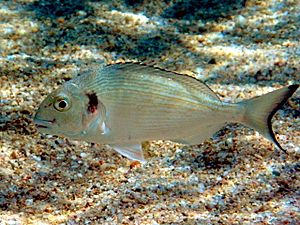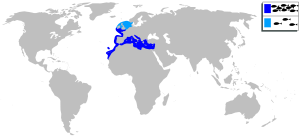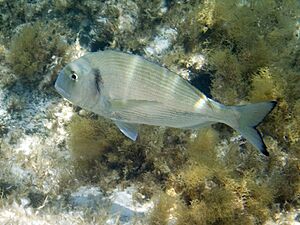Gilt-head bream facts for kids
Quick facts for kids Gilt-head bream |
|
|---|---|
 |
|
 |
|
| Conservation status | |
| Scientific classification | |
| Kingdom: | |
| Phylum: | |
| Class: | |
| Order: | |
| Family: |
Sparidae
|
| Genus: |
Sparus
Linnaeus, 1758
|
| Species: |
S. aurata
|
| Binomial name | |
| Sparus aurata Linnaeus, 1758
|
|
 |
|
| Sparus aurata - Distribution map | |
The gilt-head bream (scientific name: Sparus aurata) is a type of fish. It belongs to the Sparidae family, also known as the bream family. You can find this fish in the Mediterranean Sea and along the eastern coast of the North Atlantic Ocean.
These fish usually grow to about 35 centimeters (1.1 feet) long. However, some can reach up to 70 centimeters (2.3 feet) and weigh around 7.36 kilograms (16.2 pounds). Many people think the gilt-head bream is the best-tasting fish among all the breams.
The name Sparus comes from Latin and refers to this fish. This name was then used for the entire Sparidae family. Its special name, aurata, means "golden." This is because of the golden bar marking found between its eyes. In 2018, scientists studied the DNA of the gilt-head bream. They found interesting things about how its genes changed over time, especially those related to its unique way of reproducing.
Contents
Different Names for the Gilt-head Bream
This fish has many different names around the world. In ancient times, and still today in Italy, Malta, and Tunisia, it is called Orata.
Here are some other names for the gilt-head bream:
- In Spain and Romania, it is known as "Dorada."
- In Portugal, people call it "Dourada."
- In France, it is known as "Dorade Royale."
- In Malta, it is also called "Awrata."
Where Gilt-head Bream Live and What They Eat

Gilt-head bream usually live in waters from 0 to 30 meters (0 to 98 feet) deep. Sometimes, they can be found as deep as 150 meters (492 feet). You might see them alone or in small groups. They often hang out near seagrass beds or over sandy areas at the bottom of the sea. In the spring, they sometimes swim into estuaries, which are places where rivers meet the sea.
These fish mainly eat shellfish. They also munch on some plant material they find in their habitat.
Life Cycle of the Gilt-head Bream
Gilt-head bream have a fascinating life cycle because they can change their gender! They are known as protandrous sequential hermaphrodites. This means they start their lives as males. By the time they are about two years old, they are mature males. Later in their lives, some of these males will develop ovaries and lose their male parts, becoming females. This unique ability helps them reproduce and survive.
Fishing and Farming Gilt-head Bream
The gilt-head bream is a very popular fish to eat. People have traditionally caught wild gilt-head bream, mostly in the Mediterranean Sea. Between 2000 and 2009, about 6,100 to 9,600 metric tons of wild fish were caught each year.
Besides catching them in the wild, gilt-head bream have also been farmed for a long time. This was done in coastal lagoons and saltwater ponds. In the 1980s, new ways of farming fish were developed. This made gilt-head bream an important aquaculture species. Aquaculture means farming fish and other water animals.
Production of farmed gilt-head bream grew a lot. By 2010, about 140,000 metric tons were farmed. This is much more than the amount caught in the wild! Today, Turkey is the biggest producer of farmed seabream in the world, followed by Greece. Just like any farmed animal, gilt-head bream in fish farms can sometimes get sick from parasites.
Gilt-head Bream in Cooking
This fish is used a lot in cooking, especially in countries around the Mediterranean Sea. It's a tasty and versatile fish that can be prepared in many ways.
Here are some of its names when it's served in different countries:
- In Tunisia, it's called "wrata."
- In Greece, it's known as "tsipoura."
- In Spain, it's called "dorada."
- In France, it's known as "dorade."
See also
 In Spanish: Dorada para niños
In Spanish: Dorada para niños
- Acanthopagrus
Images for kids







